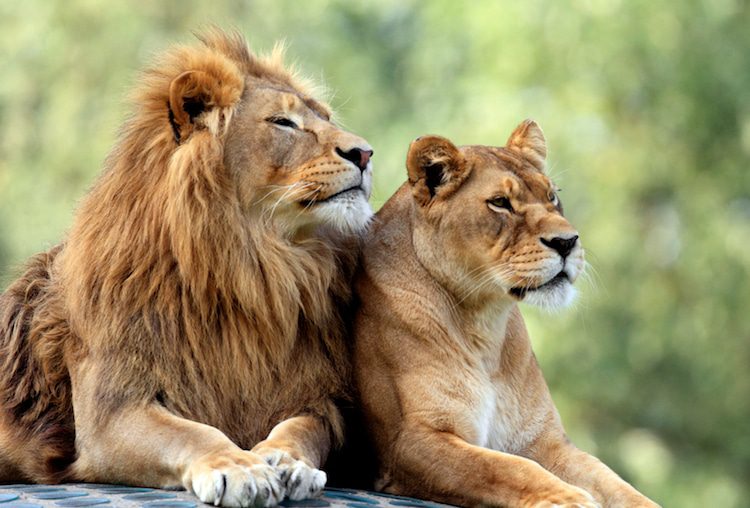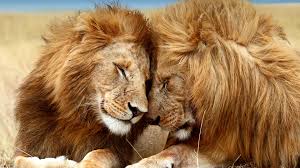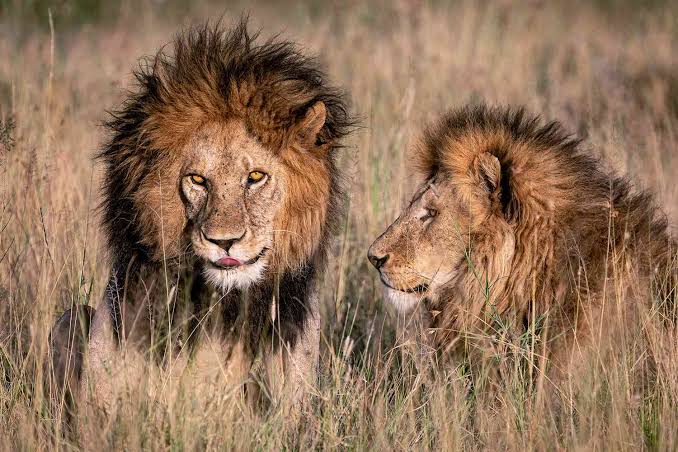The lion is a majestic and powerful animal that roams the grasslands of Africa and parts of Asia. With its golden fur and distinctive mane, the lion is often referred to as the “king of the jungle.” Lions are known for their strength, courage, and social nature.
In the wild, lions live in groups called prides. These prides are usually led by a dominant male, known as the pride’s leader or king. The lionesses, or female lions, play a crucial role in hunting and caring for the cubs. Lions are highly social creatures, and their interactions within the pride are essential for their survival.
One of the most recognizable features of a lion is its mane. The mane not only serves as a symbol of strength and dominance but also provides protection to the lion’s neck during battles with other males. Male lions use their powerful roars to communicate with other members of the pride and establish their presence in the vast savannas they call home.
Lions are carnivorous predators, and their diet mainly consists of herbivores like zebras, wildebeests, and gazelles. Hunting is a cooperative effort within the pride, where lionesses work together to bring down prey. The strong bond among pride members ensures successful hunts and the well-being of the entire group.
These magnificent creatures are also known for their lazy lifestyle, spending a significant portion of their day resting or napping. The heat of the African sun often prompts lions to seek shade under trees or relax in tall grasses. This behavior helps conserve energy for the times when they need to be active, such as during a hunt.
Unfortunately, lions face various threats in the wild, including habitat loss and conflicts with humans. Conservation efforts are underway to protect these iconic animals and ensure their survival for future generations. Through education, awareness, and responsible wildlife management, people around the world are working together to safeguard the future of the mighty lion.
In addition, the lion’s regal appearance, social structure, and role in maintaining the balance of ecosystems make it a fascinating and integral part of the animal kingdom. As we strive to coexist with wildlife, it is essential to appreciate and protect these incredible creatures, recognizing the vital role they play in the delicate tapestry of nature.
Lions also have a unique set of behaviors that contribute to their survival and social dynamics. The grooming rituals within a pride help strengthen social bonds, as lions often engage in mutual licking and nuzzling. This not only promotes a sense of unity but also serves practical purposes, such as removing parasites from each other’s fur.
Communication is paramount in the lion’s world. Roaring, as mentioned earlier, is not only a vocalization of strength but also a means of marking territory. Lions use scent marking, where they rub their heads or scratch the ground to leave their scent behind. This scent serves as a warning to other prides and helps define the boundaries of their territory.
Lion cubs are born vulnerable and dependent on their mothers for care and protection. The mother lion invests considerable time and effort into nurturing her cubs, teaching them essential hunting skills and ensuring their well-being. Cubs playfully engage with each other, honing their hunting instincts through games that mimic the challenges they will face as adults.
The life of a lion is closely intertwined with the ecosystem it inhabits. Lions contribute to the regulation of herbivore populations, preventing overgrazing and promoting biodiversity. Their presence in an ecosystem is a testament to the delicate balance of nature, where each species plays a crucial role in maintaining the health of the environment.
In the realm of mythology and symbolism, lions often represent courage, strength, and nobility. Various cultures throughout history have revered the lion for its majestic demeanor, with tales and fables often featuring these magnificent creatures as symbols of power and leadership.
As we marvel at the lion’s grandeur, it is important to acknowledge the challenges they face in the modern world. Conservation efforts, supported by governments, wildlife organizations, and concerned individuals, aim to address the threats to lion populations. These efforts involve habitat preservation, anti-poaching initiatives, and community involvement to mitigate human-wildlife conflicts.
In essence, the lion is not merely an awe-inspiring symbol; it is a living, breathing testament to the intricate connections within the natural world. Our responsibility to protect and preserve these magnificent creatures extends beyond admiration to active participation in the conservation of their habitats and the ecosystems they inhabit.
Read Also: Understanding Milk Quality and Quality Characteristics of Milk
Appearance and Features of a Lion

The lion’s appearance is striking and distinctive, making it one of the most recognizable animals on the planet. Its most prominent feature is, perhaps, the majestic mane that encircles the head of the adult male. This thick, flowing hair varies in color from blond to black and serves as a visual symbol of strength and dominance within the pride.
The body of a lion is robust and muscular, designed for power and agility. The coat, which covers the body, is typically a sandy or tawny color, providing effective camouflage in the grassy savannas where lions dwell. The fur is short, dense, and smooth, helping to regulate the lion’s body temperature in the often sweltering African heat.
The face of a lion is characterized by a broad forehead and a well-defined snout. The eyes are usually a golden or amber color, adding to the regal aura that surrounds these creatures. Lions have excellent eyesight, a crucial adaptation for spotting prey or potential threats over long distances.
Powerful jaws armed with sharp teeth and retractable claws make the lion a formidable predator. The claws, hidden within sheaths when not in use, can be extended to grasp and hold onto prey during a hunt. The roar of a lion, another notable feature, is not only an auditory spectacle but also a communication tool that can be heard over great distances, signaling strength and territorial boundaries.
While males boast the iconic mane, lionesses, the females, lack this distinctive feature. Their appearance is more streamlined, emphasizing agility and efficiency in hunting. Both males and females have tufted tails that add balance and coordination during various activities, from hunting to navigating their surroundings.
In addition, the lion’s appearance is a harmonious blend of strength and elegance. From the flowing mane that crowns the male’s head to the streamlined physique of the lioness, each feature contributes to the species’ success as a powerful predator and a symbol of wild beauty.
Health and Lifespan of Lions

The health and lifespan of lions are influenced by various factors, including their environment, access to resources, and interactions with other wildlife and humans. In the wild, lions face both natural challenges and human-related threats.
Lions typically have a lifespan of 10 to 14 years in the wild. However, their longevity can be affected by factors such as injuries, diseases, and competition within prides. Injuries sustained during hunting or territorial disputes can impact a lion’s health and reduce its chances of survival. Additionally, diseases like canine distemper and feline immunodeficiency virus can pose serious threats to lion populations.
The availability of food sources plays a crucial role in lion health. Insufficient prey can lead to malnutrition and weakened individuals within the pride. Adequate access to water is also essential for the well-being of these big cats, especially in the arid environments they often inhabit.
Human activities, such as habitat destruction and poaching, pose significant threats to lion populations. Loss of natural habitat reduces the availability of prey and can lead to increased human-wildlife conflicts as lions encroach on human settlements in search of food. Poaching, driven by the illegal wildlife trade, further endangers these majestic animals.
Conservation efforts aim to address these challenges and promote the health and well-being of lion populations. Protected areas, wildlife reserves, and initiatives to reduce human-wildlife conflict contribute to creating environments where lions can thrive. Anti-poaching measures and community involvement are crucial components of these conservation strategies.
Ensuring the health and longevity of lions requires a holistic approach that considers not only the well-being of individual lions but also the conservation of their habitats and the delicate balance of ecosystems. By addressing the various threats they face and promoting coexistence between lions and local communities, we can work towards securing a future where these magnificent creatures continue to roam the wild for generations to come.
Read Also: Guide to Milk Production, Composition, and Nutritional Value of Milk
Nutrition and Feeding Mode of Lions

Lions are carnivorous predators, and their nutrition and feeding habits are intricately tied to their role as top predators in their ecosystems. Their diet primarily consists of herbivores, and the hunting process is a coordinated effort within the pride.
Lions are opportunistic hunters, targeting a variety of prey species depending on their availability in the region. Common prey includes ungulates like zebras, wildebeests, and gazelles. The hunting strategy of lions involves stealth and teamwork, with lionesses often working together to surround and bring down their prey.
The actual hunt is a combination of strategic planning and bursts of speed. Lions utilize their keen senses, particularly sight and hearing, to locate potential prey. Once a target is identified, the pride coordinates its movements to get as close as possible before launching a synchronized attack. The element of surprise and teamwork are critical in successfully capturing prey.
After a successful hunt, lions feast on the kill, with the male, females, and cubs sharing in the spoils. Lions are known for their ability to consume large quantities of food in a single feeding, and they may gorge themselves to compensate for potential periods of scarcity between successful hunts.
The nutritional needs of lions are met through the consumption of meat, providing essential proteins and fats for their energy requirements. Organs, muscles, and bones all contribute to a well-rounded diet, ensuring that lions receive the necessary nutrients for their growth, reproduction, and overall health.
While hunting is a communal activity, the division of labor within the pride is apparent during feeding. The males, though integral to the pride’s protection and territory defense, often eat first. The lionesses follow, and finally, the cubs have their turn. This hierarchy in feeding ensures the survival of the strongest individuals within the pride.
Understanding the feeding mode of lions offers insights into their role as both predators and contributors to the balance of their ecosystems. Their dietary habits are not only vital for their own survival but also play a crucial role in regulating prey populations, preventing overgrazing, and maintaining the overall health of the ecosystem they inhabit.
Economic Benefits of Lions
Lions, as iconic wildlife species, contribute to various economic benefits that extend beyond their intrinsic ecological value. These economic advantages are often associated with tourism, conservation efforts, and the promotion of biodiversity.
1. Tourism Revenue: Lions attract tourists from around the world, especially in regions like Africa where they are a major wildlife attraction. Safari tours and wildlife reserves that feature lions generate substantial revenue for local economies. Tourists pay for accommodations, guided tours, and other services, providing a significant source of income for communities near lion habitats.
2. Job Creation: The tourism industry centered around lions creates employment opportunities for local communities. Jobs in safari lodges, guiding, park management, and conservation efforts contribute to livelihoods, reducing dependence on activities that might be harmful to wildlife, such as poaching or habitat destruction.
3. Conservation Funding: Efforts to protect lions and their habitats often involve conservation organizations and initiatives that require funding. Revenue generated through tourism and donations supports these endeavors, allowing for the establishment and maintenance of protected areas, anti-poaching measures, and community engagement programs.
4. Research Opportunities: Lions provide a platform for scientific research, contributing to our understanding of ecosystems, predator-prey dynamics, and biodiversity. Research projects often attract funding from academic institutions, government agencies, and non-profit organizations, promoting advancements in ecological knowledge.
5. Cultural and Educational Value: Lions hold cultural significance, and their presence contributes to educational opportunities for local communities and visitors. Learning about lions and their role in ecosystems fosters awareness, appreciation, and a sense of responsibility toward wildlife conservation.
6. Eco-Tourism Development: The popularity of lions can stimulate the growth of eco-tourism initiatives. Entrepreneurs may establish sustainable tourism ventures that not only showcase lions but also promote responsible travel practices, fostering long-term benefits for both the environment and local economies.
7. Biodiversity Conservation: Lions are apex predators, and their presence helps maintain the balance of ecosystems by regulating prey populations. This, in turn, supports biodiversity, ensuring the health of various plant and animal species within their habitats.
8. Carbon Sequestration: Healthy ecosystems, including those inhabited by lions, contribute to carbon sequestration. Forests and grasslands, preserved for the conservation of lions, play a role in mitigating climate change by absorbing and storing carbon dioxide.
In summary, the economic benefits associated with lions extend far beyond their immediate value in the wild. By recognizing the financial incentives tied to lion conservation, there is a greater potential for promoting sustainable practices that protect both these majestic creatures and the ecosystems they inhabit.
Read Also: Importance of Water Purification to Public Health and Safety
